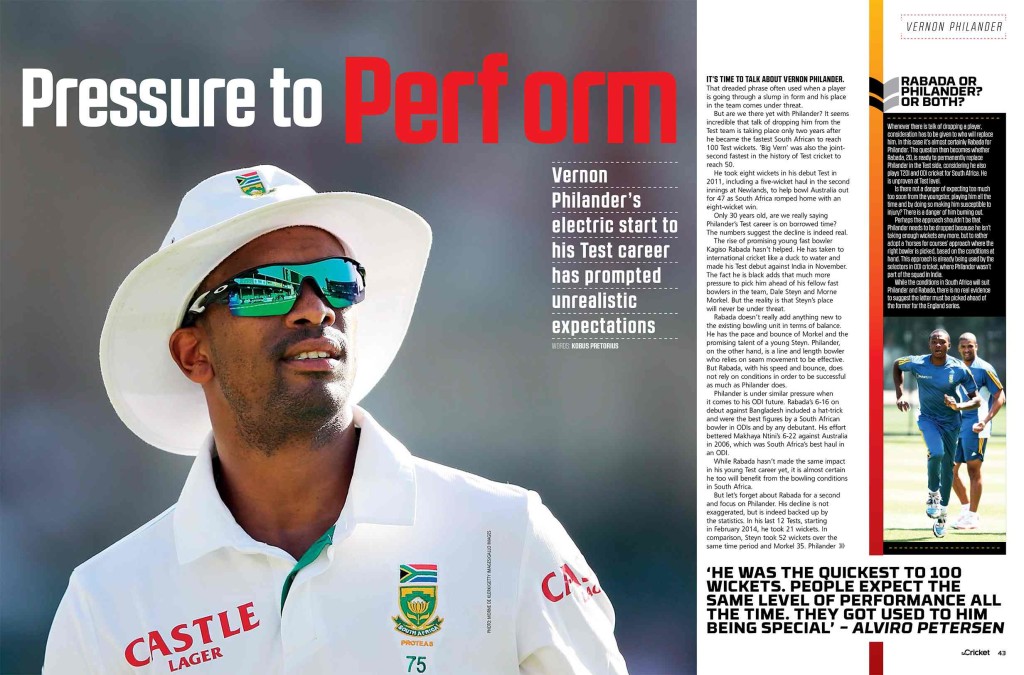On Vernon Philander’s 31st birthday, we revisit an earlier edition of SA Cricket magazine as the NZ Test series nears.
It’s time to talk about Vernon Philander. That dreaded phrase often used when a player is going through a slump in form and his place in the team comes under threat.
But are we there yet with Philander? It seems incredible that talk of dropping him from the Test team is going around only two years after he became the fastest South African to reach 100 Test wickets. ‘Big Vern’ was also the joint-second fastest in the history of Test cricket to reach 50.
He took eight wickets in his debut Test in 2011, including a five-wicket haul in the second innings at Newlands to help bowl Australia out for 47 as South Africa romped home with an eight-wicket win.
Still only 30 years old, are we really saying Philander’s Test career is on borrowed time? The numbers suggest the decline is indeed real.
The rise of promising young fast bowler Kagiso Rabada hasn’t helped. He has taken to international cricket like a duck to water and made his Test debut against India in November. The fact he is black adds that much more pressure to pick him ahead of Philander and his fellow fast bowlers in the team, Dale Steyn and Morne Morkel. But the reality is that Steyn’s place will never be under threat.
Rabada doesn’t really add anything new to the existing bowling unit in terms of balance. He has the pace and bounce of Morkel and the promising talent of a young Steyn. Philander, on the other hand, is a line and length bowler who relies on seam movement to be effective, but Rabada, with his speed and bounce, does not rely on conditions to be successful as much as Philander does.
Philander is under similar pressure when it comes to his ODI future. Rabada’s 6-16 on debut against Bangladesh included a hat-trick and were the best figures by a South African bowler in ODIs and by any debutant. His effort bettered Makhaya Ntini’s 6-22 against Australia in 2006, which was South Africa’s best haul in an ODI before that.
While Rabada hasn’t made the same impact in his young Test career yet, it is almost certain he too will benefit from the bowling conditions in South Africa.
But let’s forget about Rabada for a second and focus on Philander. His decline is not exaggerated, but indeed backed up by the statistics. In his last 12 Tests, starting in February 2014, Philander took 21 wickets. In comparison, Steyn took 52 wickets over the same time period and Morkel 35. Philander hasn’t taken a five-wicket haul in almost two years, the last time being against Pakistan in Cape Town in February 2013.
However, he played a big role in helping South Africa become the No 1-ranked Test team in the world and he has been part of a bowling attack many consider to have been the best in the world for the past three years.
With England arriving in December for a four-match Test series, where does that leave Philander?
‘I don’t think the selectors are even close to thinking about dropping him,’ says former Proteas opener Alviro Petersen. ‘Vernon took Test cricket by storm and was the quickest to 100 wickets. People expect the same level of performance all the time. They got used to him being special.
‘With England coming to South Africa I think the player they fear the most is probably Vernon, especially because they will be playing in our conditions.’
While Philander may not have taken as many wickets over the past two years as people would have liked, he has been part of a successful bowling attack. The only series South Africa lost during that time was at home to Australia. They have since beaten Sri Lanka away from home and West Indies in South Africa.
‘Bowling, like batting, is about partnerships,’ says Petersen. ‘We shouldn’t forget he also offers something with the bat, which adds a good balance to the side. If Philander does well against England, people will say he is back to his best when in reality it’s just that the conditions here suit him better.’
Philander got an ankle injury before the second Test against India and returned home, robbing him of a chance to prove his critics wrong before the England series.
‘I think the injury could be a blessing in disguise,’ says Petersen. ‘There’s no way the selectors can drop him now after only one Test in India. The injury takes him out of the limelight, which is good because the media have been putting him under pressure.’
Philander himself isn’t too fazed about the younger bowlers coming through and knocking on the door.
‘You can only take care of what you can take care of,’ he tells SA Cricket magazine philosophically. ‘And that is your performances.’
‘Good performances are not guaranteed but as long as I bowl well and do the job for the team I’m happy. I want to keep contributing to the team so we can stay No 1 in the world.’
Former South African spinner Paul Adams, Philander’s coach at the Cape Cobras, believes Rabada’s progression will add pressure on all the bowlers in the Test side.
‘You are never guaranteed a place because a team is always evolving,’ Adams says.
‘However, we shouldn’t rush into anything. Vernon has done the job for South Africa for a few years and he contributes with the bat. That side of his game is not talked about much; what he offers in that way.’
Adams believes you can’t just look at the wickets column to determine whether a bowler still adds value or not.
‘Players’ roles within the team differs,’ he says. ‘You always have to look at that. To go through a lean spell can happen to anyone, but you have to always look ahead.
‘International cricket is cut-throat and Rabada is waiting in the wings, so there will be pressure. But South Africa have a tried and tested formula which has been successful all around the world so it’s always difficult to change something that has worked so well.
‘A team can carry a player when he is struggling for form, but it’s not just about taking wickets. There are lots of other factors, too. It is important that Vernon continues to contribute as a complete package with bat and ball. He is an experienced cricketer. He just has to bowl tight, use his skill and be effective with the new ball.’
If we look ahead like Adams suggests, we’ll see a series against England about to take place. Taking everything into account, a series at home against the Ashes winners might not be the best time to drop a player who has been a big part of a team’s success since making his debut.
At 30 years of age, Philander has time on his side. If a ‘horses for courses’ approach needs to be made to get the best out of him, so be it. But to discard an experienced player, a frontline bowler who can bat at No 8, just because a talented 20 year old is knocking on the door, seems premature.
Would we be having this discussion if Philander was a batsman? Many batsman have gone 12 Tests without scoring a fifty or more and survived.
Philander should get the benefit of the doubt. At least until after the England series.







